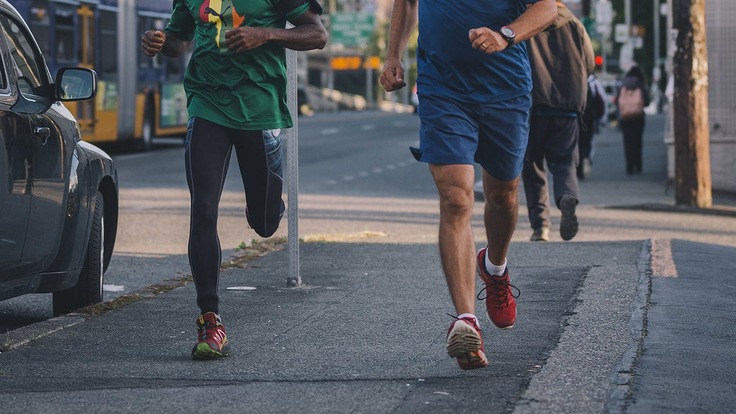Congrats on making the decision to participate in a distance race. Running does wonders for your cardiovascular fitness, mental alertness and overall health. It's also one sport you can train for virtually anywhere.
Be sure to allow yourself eight to 12 weeks to prepare for your half marathon race, consult with your doctor or trainer before undertaking a new training routine and, most importantly, have fun.
Set a Half Marathon Training Schedule
When prepping for an event such as a half marathon, include running in your routine about three to four days per week:
- One moderately paced shorter run
- One race-paced (fast and challenging) shorter run
- One long run
- One easy jog day or cross-training day
Combined with one day for resistance training, this allows for two days per week of essential rest and recovery. Make sure you spread out these recovery days to allow adequate rest between each training session.
Do you have Wednesdays off and want that to be your long run day? No problem—just reorganize the training days and ensure enough rest after the challenging workouts.
Sample Week
| Monday | Tuesday | Wednesday | Thursday | Friday | Saturday | Sunday |
|---|---|---|---|---|---|---|
| Resistance workout | Short run (3 miles), moderate pace; | Rest | Short run (2.5 miles), race pace | Rest | Long run (3.5 miles) | 30-minute easy jog or cross training |
Where to begin: Your starting mileage will depend on your current fitness level. If you haven't been doing any aerobic exercise, you may start with only one mile at a time (or less) during each training session for the first week or two.
How to progress: Whatever your starting mileage, the key is to progress slowly to help avoid injury. To allow for appropriate progression, don't increase your running volume more than 10 percent from week to week. For example, if your total mileage during a week of training is 10 miles, the following week should not be more than 11 miles.
Note that training up to the full half marathon race distance is helpful, however, you may still be able to complete the event if you have trained up to at least 10 miles at least twice during your training plan.
For first timers, it is helpful to train up to, and perhaps beyond, the race distance, to allow for increased confidence going into the event day.
Race Training and Rest
Resistance training while prepping for a race is critical for improving running alignment and efficiency, and to help stabilize joints that will endure the repetitive impacts of running. Perform your resistance-training workout at least once, if not twice, weekly during your training plan. Be sure to allow adequate recovery after each resistance workout before completing a hard run.
Varying your aerobic activity will help prevent overuse injuries and burnout from running. Get creative and have fun with these workouts—swimming, biking and cross-country skiing are all great options—and try to switch these up from week to week.
Sleep is by far the most important part of your training program. This is when your muscles rebuild after your training sessions to help you perform better. Aim for seven to eight hours of sleep nightly by establishing a regular sleep schedule and turning off electronics at a set time in the evening.
Sample Resistance Workout
The following workout is a guide, and over the course of your training you may seek out additional exercises for variety. If you have any questions about your ability to perform the exercises properly and safely, be sure to consult with your doctor or trainer.
Standing Chest Stretch

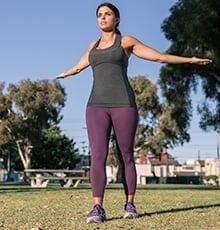
- Assume a staggered stance and extend both arms in front of your chest with your palms facing upward.
- Slowly reach the arms outward and open the chest.
- Stretch your arms past your shoulders if possible, while keeping the arms straight and thumbs rotated backward. Hold for 30 seconds on each side.
- If you have a doorway available, bend both elbows at 90 degrees and press the elbows into the doorframe as you lean forward. Keep your arms at or below shoulder height to protect your shoulder joints.
Jump Ups
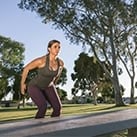
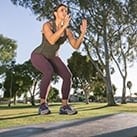
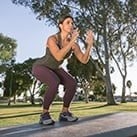
Perform two sets of 10 jumps with a one- to two-minute rest between sets.
- Select a stable surface that is 12 to 36 inches in height, depending on your ability and comfort level.
- Stand facing the elevated surface. Slightly bend your knees and hinge at your hips and then explode off the ground, landing on the elevated surface in a similar position with toes pointed forward. The landing should be quiet to absorb the force. Step down and repeat.
- As your vertical leap improves, try jumping onto higher surfaces. If your form is compromised, or if you are not able to land with your feet completely on the surface, drop back down to a lower height. Step down between jumps to avoid injury.
Kettlebell Goblet Squats

Complete two sets of 10 reps with a 30- to 60-second rest between sets.
- Hold a kettlebell by the horns (or use any weight) up against your chest.
- Position your feet a little wider than shoulder-width apart and turn your toes out slightly (the less mobile the hips, the more the toes will need to turn out).
- Drop your hips straight down toward the ground, keeping your chest open and shoulders anchored down and back.
- Pretend you are separating the ground with your feet and engage your glutes as you power back up to the starting position.
Modification: This exercise can be performed as a body-weight squat (without the added weight), or as an assisted squat with a suspension trainer. If you are unable to perform this exercise as shown, remove the load and/or reduce your range of motion.
Row
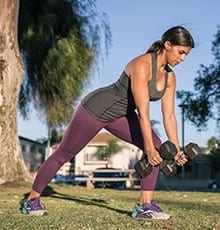
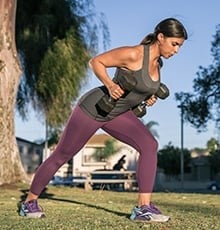
Perform two sets of 10 repetitions, resting for 30 to 60 seconds between each set.
- Using kettlebells or other hand-held weights, begin in a staggered stance (one leg forward, one leg back) with the weights below the shoulders.
- Hinge forward from the hips and begin the row by retracting and depressing your shoulder blades, and then follow through by pulling your elbows toward your rib cage. Keep your trunk straight and stable, and don't let your back round or arch while going through the movement.
Modification: This row can also be performed using one arm at a time or while using an exercise band.
Walking Lateral Lunges
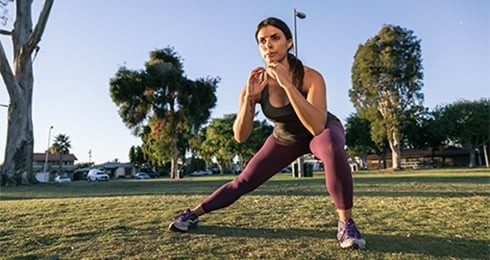
Complete two sets of 10 repetitions in each direction, resting for 30 to 60 seconds between sets.
- Step directly sideways to the left with the left toe pointed directly forward.
- Bend the left knee (making sure it tracks over your foot without turning in or out) and allow the left hip to drop down and back so you are sitting in a squat, with your right leg still straight.
- Brace that hip and keep the right leg straight as you step the right leg in and repeat. Make sure your chest stays up and open.
Modification: To lower the intensity, perform standing lateral lunges with a wide stance and shift your weight side to side.
Single-Leg Romanian Deadlifts
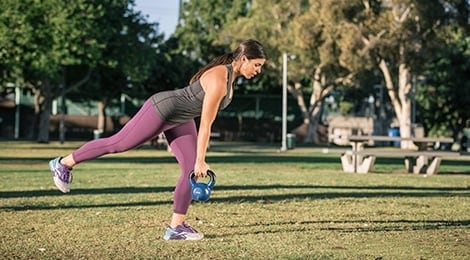
Perform two sets of 10 repetitions on each leg, resting for 30 to 60 seconds between sets.
- Begin by holding a kettlebell (or other hand-held weight) in the opposite hand of the planted foot.
- Keep a neutral spine and only a slight bend in the planted leg as you hinge forward while lifting your other leg and keeping it straight from the hip.
- Once you have achieved your end range of motion (your body should form a capital T if you have the mobility), lower that leg back to the ground.
Modification: If you are struggling with perfect form, remove the weight and first master the hip hinge.
Planks
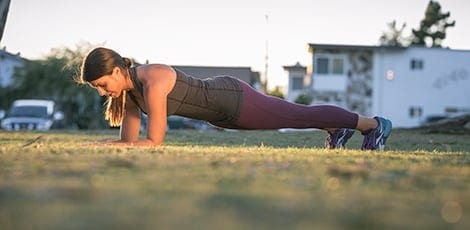
Perform the plank for 10 seconds on, two seconds off, for four sets.
- With only the toes and forearms on the ground (with elbows directly under the shoulders), brace every muscle of your body (especially the glutes) and hold a perfectly straight line from head to toe, without letting your hips sag or raise up in a V-shape.
- Shorter, tighter planks will lead to better strength gains. To progress your plank, try raising a leg or an arm to increase the challenge.
Modification: Place your knees on the ground if you cannot complete a 10-second plank without your hips sagging.
Side Band Walks
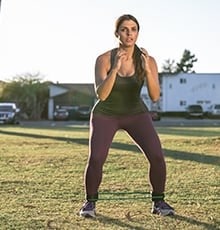
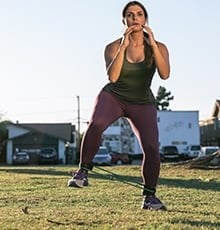
Complete two sets of 15 repetitions in each direction, resting 30 to 60 seconds between sets.
- Begin in a shoulder-width stance and a half squat; loop a resistance band around your ankles.
- Maintain the half-squat position as you step into a wider stance with your left foot.
- Next, without dragging it, bring the right foot back to the shoulder-width distance. Ensure your toes stay pointed forward at all times and your posture remains upright. Don't allow the knees to track inward.
- For added challenge, place the resistance band above the knees.
Half-Kneeling Hip-Flexor Stretch
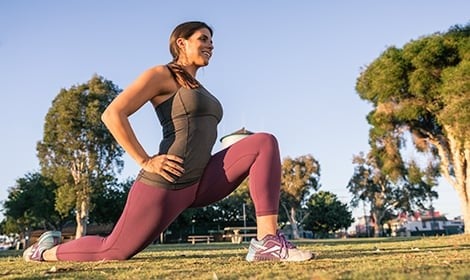
- Begin in a half-kneeling position, with the left foot out in front.
- Press forward to feel a stretch in the hip flexors of the right hip. Do not overextend the lumbar spine—you shouldn't feel any pain in your back during this stretch. Hold for 30 seconds on each side.
- Add an upper-body (lat and oblique) component by reaching the right arm up by the ear and leaning over to the left.
The nonprofit American Council on Exercise (ACE) educates, certifies, and represents more than 53,000 fitness professionals, health coaches, and other allied health professionals.
This article is not intended to provide medical advice on personal health issues, which should be obtained directly from a physician.
